Recent Mold Remediation Posts
Mold Clean up
1/31/2024 (Permalink)
Discovering mold in your home isn't just an aesthetic concern; it poses significant health risks. Mold spores, once airborne, can trigger allergies, respiratory issues, and even more severe health conditions. In the battle against mold, SERVPRO of Brown County emerges as your trusted ally.
Mold-related health effects can range from sneezing and skin irritation to serious respiratory problems. Ignoring mold can exacerbate these issues, making timely cleanup essential. SERVPRO's specialized mold remediation team boasts the expertise to not only eliminate visible mold but also address hidden colonies and prevent recurrence.
Hiring SERVPRO of Brown County for mold cleanup ensures a comprehensive and professional approach. Their trained technicians utilize advanced techniques and equipment to mitigate health risks and restore your home to a safe environment. Protect your well-being by choosing SERVPRO for efficient and thorough mold remediation – because a healthy home is a happy home.
Mold Containment Keeps You Safe
1/30/2019 (Permalink)
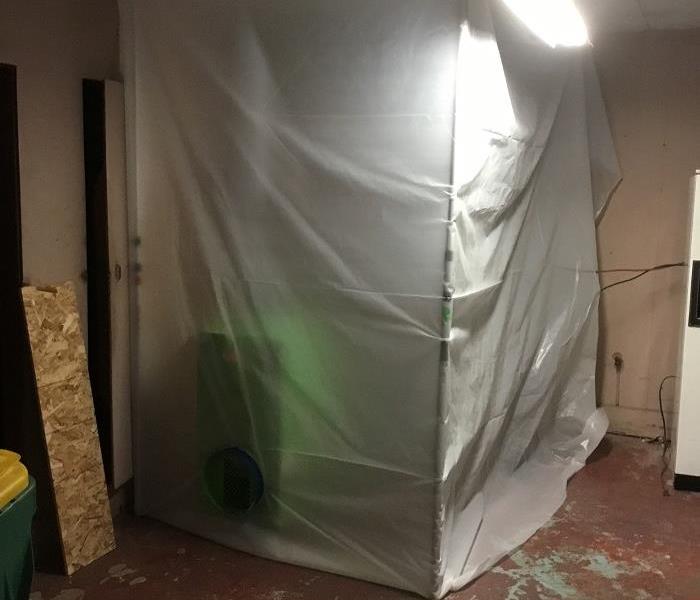 Mold containment setup
Mold containment setup
Team SERVPRO of West Brown County is trained and ready to take on any mold remediation projects at homes and businesses across the Green Bay area.
Along with the right training and equipment, our technicians make sure to perform mold clean up in the safest way possible.
As we know, there is evidence that mold can create irritants and allergens that can have an impact on people’s health. Remediation can cause mold spores to spread in the air, so that means an increase risk in those irritants and allergens spreading as well.
To prevent the spread of those spores, our technicians set up what’s called containment while cleaning to keep the spores to the affected areas.
First, techs will make sure all heating and cooling systems are turned off during the remediation process, to keep moving air from blowing the spores around.
Then, our techs will build physical barriers using plastic sheeting. They will also used advanced techniques like creating negative air chambers to keep the mold spores within those physical barriers.
Our team is also trained to use specialized air filtration equipment like HEPA vacuums and air scrubbers to keep the air clean.
Your safety is always our number one priority and by setting up containment on each and every mold job we do, we are ensuring your safety.
If you need help with a mold issue at your home or business, call SERVPRO of West Brown County at 920-434-8224.
Mold and Cold: What You Need to Know
11/13/2018 (Permalink)
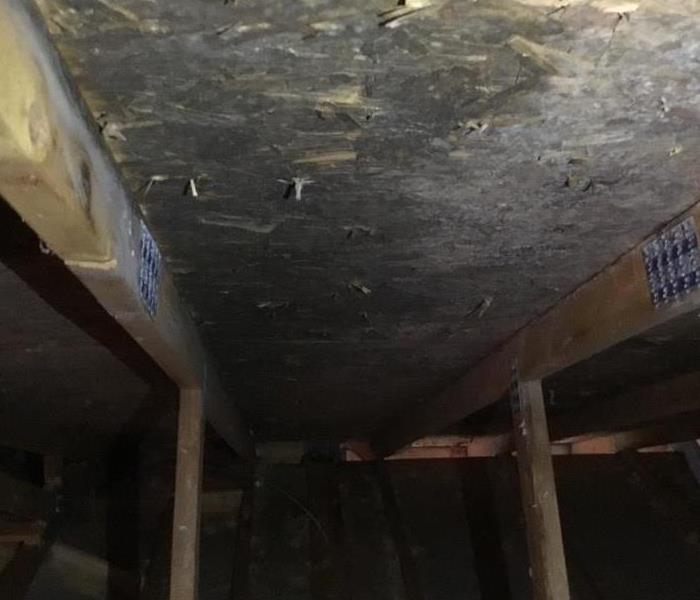 Photo of mold inside a home.
Photo of mold inside a home.
We’ve written and posted many times about mold in the past.
So, by now you probably know that it’s a sneaky fungus that grows given three optimal conditions: a food source, moisture and an ideal temperature (70-90 degrees are most conducive to mold growth, but the spores can thrive anywhere from 32 to 120 degrees).
But as much as you might know about mold, did you know the cold, late fall and winter months can be ideal times for mold to grow in your home?
This may come as a surprise since we know mold likes those warmer temperatures. However, despite the cold air outside and dry air from heating systems inside, certain areas of the house may be more prone to warm, humid air than they would during other times of the year.
Bathrooms and kitchens are two areas that get a lot of hot, steamy air and they may not have the proper ventilation to let that steam out. This can be a particular problem in winter, because you’re less likely to have any windows open when the weather outside is frightful. Mold will take any chance it can get to start growing in that nice, humid environment.
And as the cold air from outside hitting windows and doorways meets hot air from inside the home, condensation will likely develop around those windows and doors. Mold loves to grow where condensation exists.
Another concern with cold weather and mold is that the fungus can and does flourish in dead vegetation (like those leaves that may be covering your yard as we speak!). Even a frost is unlikely to kill mold spores, so when you walk through those dead leaves and then into your house, the spores can hitch a ride on your shoes or clothes. The more spores that make it inside, the more likely you’re going to have a mold problem.
No matter the season, it’s always a good idea to be on the lookout for mold in your home. If you see it growing, you can always count on SERVPRO of West Brown County for help with mold remediation. Call us any time at 920-434-8224.
Yes, Mushrooms CAN Grow Inside Your Home
5/22/2018 (Permalink)
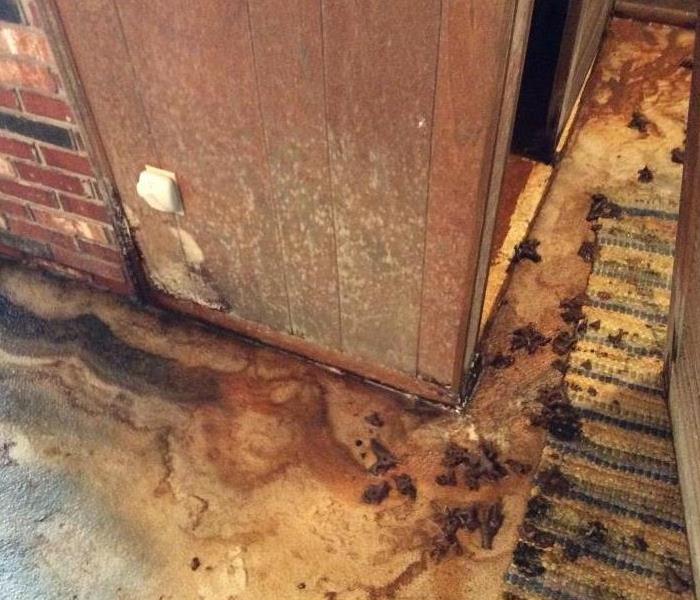 Mushrooms growing out of floor
Mushrooms growing out of floor
We recently did a big cleanup job at a Green Bay area home that experienced a water loss.
As with many water losses, aside from the damage the water itself caused, mold was growing all over the house. But something a little different with this case was that, along with the mold, mushrooms were growing out of the carpeted floors as well! That’s right, honest to goodness mushrooms were growing out of the floors. (In the photo we posted with this blog, you can see the mushrooms, they’re the brown spots on the floor)
What happened was the house was unoccupied and the boiler broke, which led to water and high humidity across many of the rooms. Because the home was not occupied, the situation sat for a long time before the owners found it. As the mold grew, so too did the mushrooms.
Like mold, mushrooms are fungi. They require moisture, a food source and oxygen to grow. Factor in the right temperature and they’ll grow. It’s actually not all that unusual for mushrooms to grow in a home when the conditions are just right.
SERVPRO of West Brown County was called in to clean up. We dried up the home and cleaned up and remediated the mold and mushrooms.
Unfortunately, when mold and fungi get to this point in a home, a lot of the building materials, like affected drywall and flooring, need to be fully removed to ensure all the water damage and the fungus growth is removed. Once the affected walls are down to the studs, we then make sure any mold on them is fully removed. Then the surfaces are cleaned and all remaining surfaces are HEPA vacuumed to remove any traces of mold spores.
Fortunately, once our cleanup was complete, the owner was able to have the home rebuilt and it is now in beautiful condition.
If you notice fungi of any kind growing in your home or business (mushrooms included!), we can help take care of that problem for you. Just give us a call at 920-434-8224.
How Mold Sneaks into Your House
5/15/2018 (Permalink)
 Mold growing on a piece of furniture in the Green Bay area
Mold growing on a piece of furniture in the Green Bay area
As we’ve said time and time again, mold is a very tricky, sneaky fungus. It likes to infiltrate your home or business and grow where you might not expect or even be able to see it.
According to the CDC, mold spores are found pretty much everywhere: indoors and outdoors. With about 100,000 of varieties in existence, it’s no surprise we come into contact with molds of all kinds on a daily basis. Some of those contacts are more positive than others.
We don’t have to tell you, mold growing on walls or furniture in your home or office are on the negative side of things.
The CDC says outdoor mold spores can get inside through pathways like open windows and doors, as well as heating and air conditioning systems and vents. The spores can also hitch a ride on you, your clothing, shoes and even your pets!
The website homes.com also has a list of ten “unexpected” places mold can sneak inside and start growing. The site says a good rule of thumb is that “if it uses water, chances are it’s going to leak,” and if it leaks, chances are mold can grow there.
So, what are those ten places? Here’s the list:
- The dishwasher
- Icemaker connections
- Washing machine connections
- Hot water heater
- Plastic “p-trap,” a connection under your sink
- Toilet connections
- Shower doors
- Tub
- Exterior hose bib
- Outdoor sprinklers (these can spray water on your home at an angle that is optimal for mold growth)
The CDC says the way to prevent mold from growing in these places and spreading to more of your property is to keep them as clean as possible. The best advice is to try to control humidity levels in your home, promptly fix any leaky pipes or water connections (or leaks in roofs or windows!), and ventilate shower, laundry and cooking areas.
According to the CDC, there is evidence that links indoor mold exposure to certain health issues like upper respiratory tract reactions.
So, to keep the air clean and safe in your home, try to keep things as dry as possible!
And if you see or suspect mold growth in your home, give SERVPRO of West Brown County a call. Our technicians are trained to specialize in fast and efficient mold remediation. You can reach us any time at 920-434-8224.
Many Kinds of Mold
4/29/2018 (Permalink)
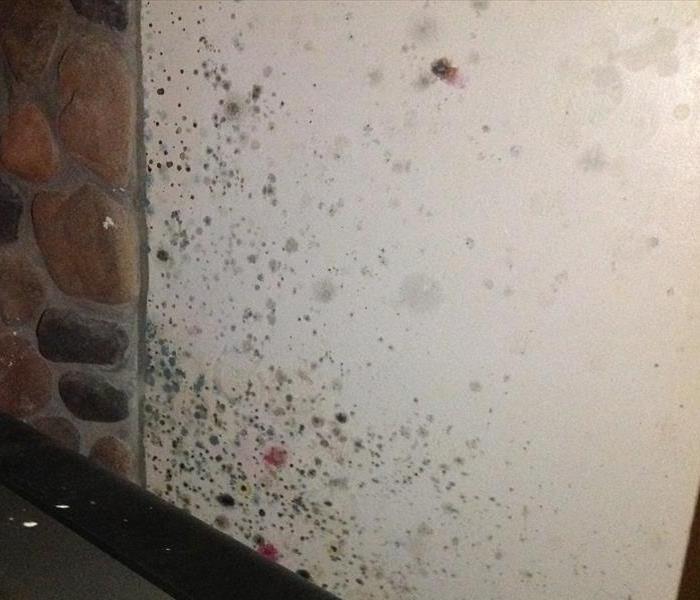 Photo of mold growing inside a home in the Green Bay area
Photo of mold growing inside a home in the Green Bay area
Mold remediation is one of the most common jobs we help our clients with.
Because of that we’ve focused some recent blog posts on mold: where it’s likely to grow in your home, what to expect if you call us for help with remediation.
But did you know there are many kinds of mold that can affect your property?
We do know there are more than 100,000 species of mold that exist in the world. Not all of these can or will affect your home or office, but there are five main kinds you’re likely to encounter:
- Alternaria – is a genus of mold, meaning there are several species that are contained within it. Alternaria tends to grow in thick green, gray or black colonies. According to health experts it can affect a person's health.
- Aspergillus – is a genus of mold. One of the species is a main component of mildew. Health experts say some species of Aspergillus can affect a person's health.
- Cladosporium – Is another mold genus. The species within Cladosporium grow in olive-green, brown or black colonies. Cladosporium is rarely known to have adverse health effects on people.
- Penicillium – This mold genus contains over 300 species, some of which are used to make the medicine Penicillin, some of which are used to make cheese. However, some of those species can be commonly found growing in blue or blue-green colonies on plywood, carpet and inside walls.
- Stachybotrys chartarum – is the mold species the CDC considers ‘black mold,’ which you’ve likely heard of as ‘toxic mold.’ This species grows in greenish-black colonies and is actually NOT toxic. The CDC CAN have an effect on people's health, particularly those with weakened immune systems. (We wrote a full blog on this mold a few weeks back)
So now that we’ve told you a little bit about some of the different kinds of molds are out there, let us remind you that we can help clean up and mitigate ALL of them. So, if you’ve found mold growing in your home or business, reach out to SERVPRO of West Brown County at 920-434-8224.
The Mold Remediation Process
4/24/2018 (Permalink)
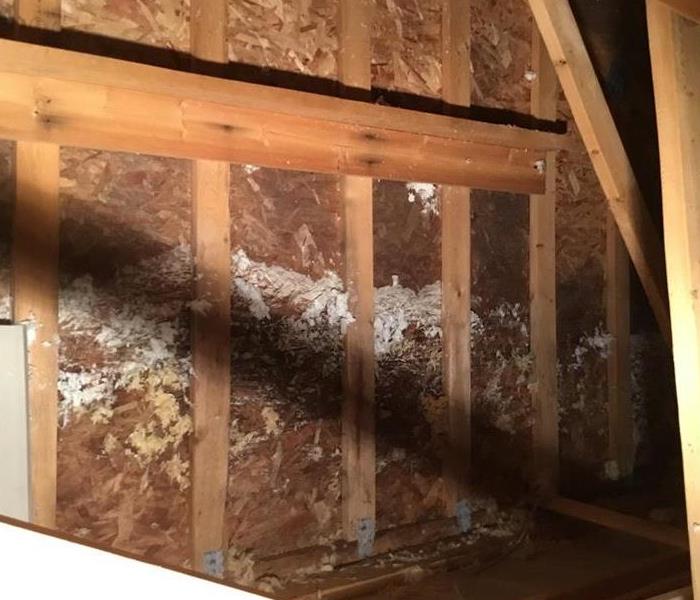 Mold growing inside a home in the Green Bay area.
Mold growing inside a home in the Green Bay area.
Recently we posted a video about a process the team at SERVPRO of West Brown County works on a lot: mold remediation. We thought a good idea would be to expand upon that video with a blog post explaining what you can expect when you call us in to your home or business for a mold remediation project.
As we’ve said in the past, mold will grow on wet, porous materials. The longer something like drywall or carpeting is wet, the more likely it is to experience mold growth.
So, at the first sign of fungus, call us at 920-434-8224.
Once our technicians arrive, they will do a full check to see where the mold is growing. Then they will set up a containment space to ensure mold spores do not travel outside of the affected areas.
The techs will set up that containment space by creating a negative air chamber by putting up actual plastic barriers. Then they will run a high-efficiency air scrubber that will contain the mold spores and keep the rest of the air in the building clean.
Our team may need to remove some affected building materials like drywall and carpeting if they experience mold growth. Often, those kinds of materials are not salvageable after mold. The technicians will clean any structural materials that cannot be taken out with a mold stain removal product.
In the final step of the mold remediation process itself, team members will spray anti-bacterial and anti-microbial solution over the affected areas to ensure they’re as clean as possible.
Our employees can also perform any reconstruction or rebuilding that may need to be done as a result of the mold remediation process.
We are available 24 hours a day, 7 days a week. Call us at the first sign of mold.
Where Mold Could Be Hiding in Your House
4/20/2018 (Permalink)
 This is a photo of mold at a Green Bay area home before we cleaned it up.
This is a photo of mold at a Green Bay area home before we cleaned it up.
As we’ve said in the past, mold can be a very tricky fungus, sometimes growing behind walls and under carpets. But did you know there are areas all over your home mold could be hiding?
It’s true and it can happen even if you don’t experience a flooded home. Luckily, there are some things you can do to try to stop mold from growing. Many of these good practices involve keeping materials dry and ensuring good air circulation. The Environmental Protection Agency (EPA) has a list of rooms you might find mold and advice for stopping it in its tracks:
- The attic or roof: the EPA says not to ignore wet spots up here and have any leaks fixed ASAP.
- Bedrooms and closets: the EPA says not to ignore wet or flaking paint. Try to keep the humidity levels to between 30% and 60%.
- Bathrooms: all the water and steam here can cause mold growth. Try to run the exhaust fan or open a window when showering.
- Kitchen: leaking pipes can lurk under the sink, get them fixed! Cooking can also cause humidity, so run your kitchen’s exhaust fan.
- Basement: keep a dehumidifier down here and ensure your clothes dryer is properly vented to the outside.
- Yard: water pooling around the house can lead to moisture inside. Set up outdoor drainpipes at least five feet from the foundation and ensure land around the house slopes downward and away from the house.
- Windows: condensation on windows can be a sign of high indoor humidity!
The EPA says mold can cause immediate or delayed allergic reactions and can also cause asthma attacks in people who suffer from asthma. In addition, mold can irritate the eyes, skin, throat, nose and lungs of people with and without allergies. According to the EPA, research into mold’s effect on people’s health is ongoing.
To help ensure healthy air quality, SERVPRO of West Brown County is fully prepared to handle mold remediation at your Green Bay area home or business. You can always reach us at 920-434-8224.
And be on the lookout for our next blog post where we’ll describe and explain the equipment and techniques our team uses to clean up mold. That post will go live in two days!
A Word About Black Mold
4/4/2018 (Permalink)
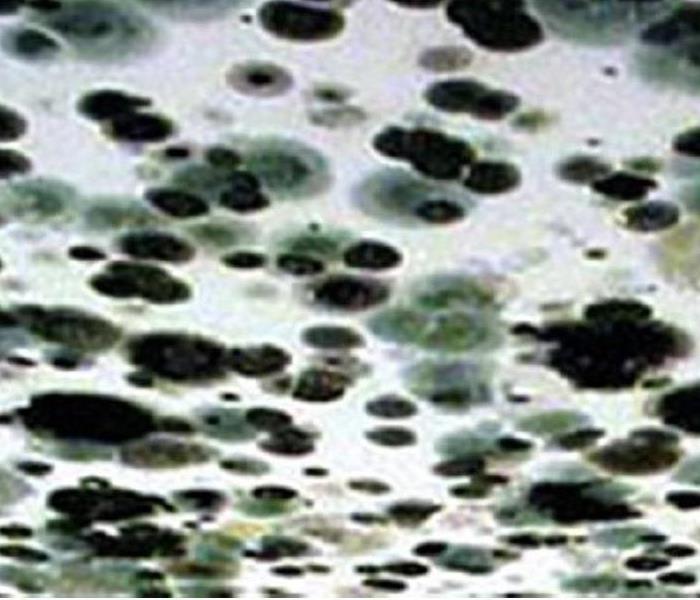 A photo of black mold growth from the Centers for Disease Control and Prevention.
A photo of black mold growth from the Centers for Disease Control and Prevention.
You’ve likely heard of black mold or, as some call it, “toxic mold.” The information about this fungus can be confusing and downright alarming, depending on what, exactly, you’ve heard.
According to the CDC, the term “toxic mold” is incorrect. The black mold, scientifically known as Stachybotrys chartarum, is not actually poisonous.
The CDC says there IS evidence, however, that black mold can cause “hay fever-like allergic symptoms” like coughing and wheezing. Studies show the people most at risk of having reactions are those with chronic respiratory diseases like asthma.
The mold will grow in wet environments. So, it can show up after flooding, water leaks, even severe humidity. It usually brings with it a musty smell.
And that is where the SERVPRO team comes in. We are trained and fully equipped to tackle black mold, or any mold variety you might be having trouble with in the Green Bay area.
After you’ve contacted us to do mold remediation at your home or business, there are a few things you need to do (or not do!)
- Stay out of the mold affected areas.
- Turn off HVAC system and fans.
- Do NOT touch the mold.
- Do NOT blow air across the moldy surfaces.
- Do NOT try to dry the moldy surfaces yourself.
- Do NOT try to clean up the moldy areas with bleach or disinfectants.
Our team is fully trained to use special techniques and equipment to handle the mold growth safely.
We will first inspect your property for any signs of the fungus, keeping in mind that it can grow underneath carpeting and behind walls.
Once we’ve identified where all the mold is, we will work to contain it to the contaminated areas. That means using negative air chambers to prevent the mold spores from spreading. We’ll also perform air filtration using “air scrubbers” and HEPA vacuums.
We will then administer anti-fungal and anti-microbial treatments on affected areas. This may require going so far as to tear out any affected materials like drywall and carpeting.
We can also clean and disinfect any salvageable personal items like furniture, clothing and curtains and remove any remaining odors from the mold using fogging equipment.
Finally, If SERVPRO did have to remove any structural materials like walls or flooring, we are equipped to provide reconstruction services to complete the job. We want to leave your property looking its very best.
It’s important to remember: significant mold growth can occur over as little as 24 to 72 hours. So, if you suspect you have a problem, call us at SERVPRO of West Brown County as soon as possible. You can reach us as 920-434-8224, 24 hours a day.
Does Your Brown County Home Have A Mold Problem?
8/28/2017 (Permalink)
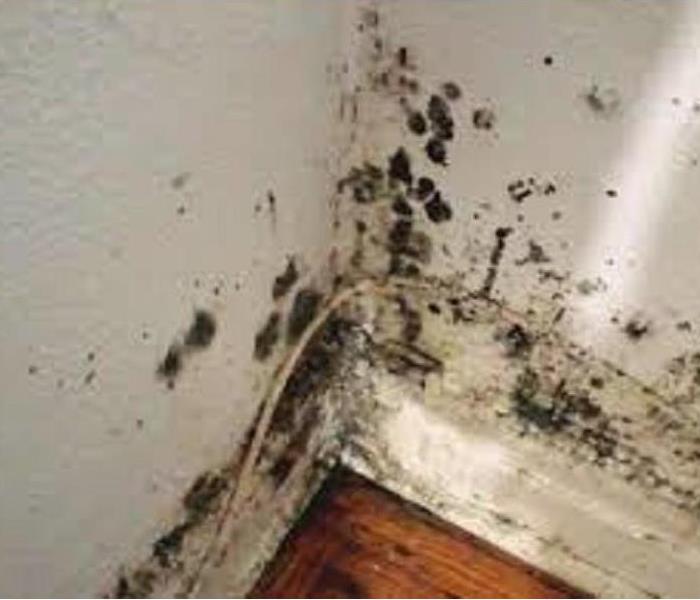 In Brown County, mold can spread through a home in as little as 48 hours.
In Brown County, mold can spread through a home in as little as 48 hours.
Microscopic mold spores naturally occur almost everywhere, both outdoors and indoors. This makes it impossible to remove all mold from a home or business. Therefore, mold remediation reduces the mold spore count back to its natural or baseline level. Some restoration businesses advertise “mold removal” and even guarantee to remove all mold, which is a fallacy. Consider the following mold facts:
- Mold is present almost everywhere, indoors and outdoors.
- Mold spores are microscopic and float along in the air and may enter your home through windows, doors, or AC/heating systems or even hitch a ride indoors on your clothing or a pet.
- Mold spores thrive on moisture. Mold spores can quickly grow into colonies when exposed to water. These colonies may produce allergens and irritants.
- Before mold remediation can begin, any sources of water or moisture must be addressed. Otherwise, the mold may return.
- Mold often produces a strong, musty odor and can lead you to possible mold problem areas.
- Even higher-than-normal indoor humidity can support mold growth. Keep indoor humidity below 45 percent.
If your home or business has a mold problem, we can inspect and assess your property and use our specialized training, equipment, and expertise to remediate your mold infestation.
If You See Signs of Mold, Call Us Today – 920-434-8224
Brown County Residents: Follow These Mold Safety Tips If You Suspect Mold
7/18/2017 (Permalink)
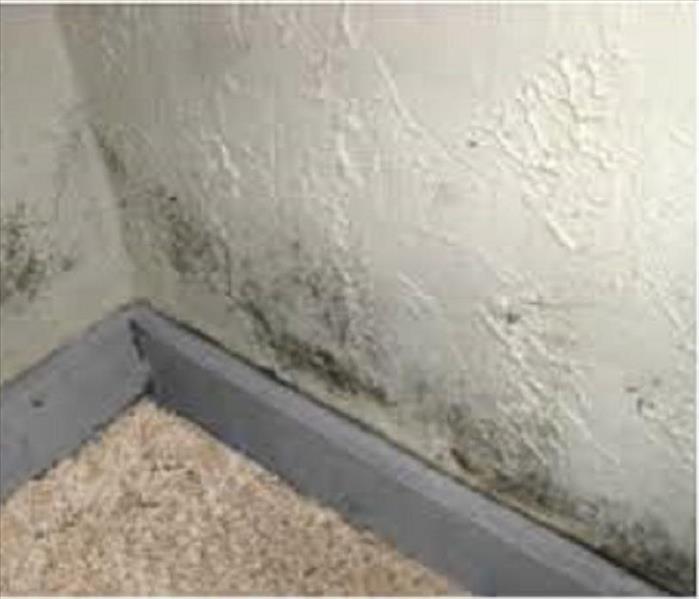 Be careful! Without proper training, you could be spreading mold throughout your home.
Be careful! Without proper training, you could be spreading mold throughout your home.
If you see visible mold, do not disturb it. You can inadvertently spread the mold infestation throughout your home. When mold is disturbed, the mold can release microscopic mold spores which become airborne and can circulate inside your home.
What to Do:
- Stay out of affected areas.
- Turn off the HVAC system and fans.
- Contact SERVPRO of West Brown County for mold remediation services.
What Not to Do:
- Don’t touch or disturb the mold.
- Don’t blow air across any surfaces with visible or suspected mold growth.
- Don’t attempt to dry the area yourself.
- Don’t spray bleach or other disinfectants on the mold.
About Our Mold Remediation Services
SERVPRO of West Brown County specializes in mold cleanup and restoration, in fact, it’s a cornerstone of our business. Our crews are highly trained restoration professionals that use specialized equipment and techniques to properly remediate your mold problem quickly and safely.
If You See Signs of Mold, Call Us Today – 920-434-8224


 24/7 Emergency Service
24/7 Emergency Service



